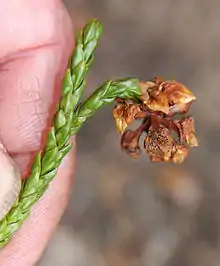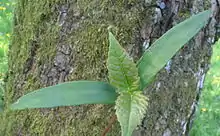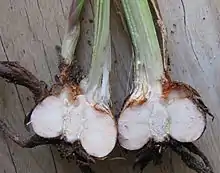Cataphyll
In plant morphology, a cataphyll (sometimes also called a cataphyllum,[1] or cataphyll leaf[2]) is a reduced, small leaf.[3][4] Many plants have both "true leaves" (euphylls) which perform the majority of photosynthesis, and cataphylls that are modified to perform other specialized functions.[5] Cataphylls include bracts, bracteoles, and bud scales, as well as any small leaves that resemble scales, which are known as scale leaves.[3][4] Some cataphylls have a primary function other than photosynthesis. The functions of cataphylls such as bud scales may be short-lived and they are often shed after the need for them is past.
_showing_imbricate_cataphylls_5405.jpg.webp)

Etymology
From the Greek Ancient Greek: κατά, down, Ancient Greek: φύλλον, leaf.[6]
Forms of cataphylls
Some kinds of cataphylls perform a transient function, after which they die and may be shed. Those that are shed early are said to be caducous, but that term can apply to any organ that is shed early, not only leaves; for example, many Geraniums have caducous stamens. The sepals of Papaver species are shed during the very opening of the petals, and as such they are a dramatic example of caducous leaves. Many other forms of cataphylls, such as some spines, are persistent, but cannot perform their major function until they die, whether they physically get shed or not. Examples of various kinds of cataphylls include bud-scales, bulb-scales, corm-scales, rhizome-scales, cotyledons, scaly bracts, spines.[2] Each of these occurs in various forms and contexts; for example, bud-scales occur on various kinds of leaf or branch buds as well as on flower buds.
Protective masses of dead leaves encircle the stems of some species of palm trees or aloes, but those are not usually regarded as cataphylls because their primary function while alive was photosynthesis, as is usual for true leaves.
Cotyledons as cataphylls

Cotyledons are widely regarded as a class of cataphyll, though many kinds of cotyledon function as living tissue and remain alive till the end of their function at least, at which time they wither and may drop off. They begin as leaf rudiments and many kinds accumulate nutrient materials for storage, starting to give up their stored material as the plant begins to germinate. Some, such as the cotyledons of many legumes, conifers, and cucurbits, even develop chlorophyll and perform the first photosynthesis for the germinating plant.
Spines as cataphylls
.jpg.webp)
It also is a matter of context and preference whether one regards any particular kind of spine as a cataphyll or not. The terminology for glochids in particular is confusing, as they are variously and arbitrarily referred to as spines, bristles and more. Morphologically only spines could strictly speaking be cataphylls, because the others are not leaves, but in the current context the point is hardly worth pursuing.
Corm-scales


Like bulb-scales, corm-scales are largely the basal parts of the photosynthetic leaves that show above ground. Some species of cormous plants, such as some Lapeirousias also produce cataphyllous leaves that act as practically nothing more than tunic leaves for the corm.[7] Unlike bulb-scales however, the corm tunic has no significant storage function; that task is left to the parenchyma of the cortex of the corm.
See also
- Leaf shape
- Leaf size
References
- Stearn, W.T. (1992), Botanical Latin: History, grammar, syntax, terminology and vocabulary (4th ed.), David and Charles, ISBN 0-7153-0052-0
- Jackson, Benjamin, Daydon; A Glossary of Botanic Terms with their Derivation and Accent; Published by Gerald Duckworth & Co. London, 4th ed 1928
- Hickey, M.; King, C. (2001), The Cambridge Illustrated Glossary of Botanical Terms, Cambridge University Press
- Beentje, H.; Williamson, J. (2010), The Kew Plant Glossary: an Illustrated Dictionary of Plant Terms, Royal Botanic Gardens, Kew: Kew Publishing
- Bell, A.D. (1997), Plant form: an illustrated guide to flowering plant morphology, Oxford, U.K.: Oxford University Press
- Chisholm, Hugh, ed. (1911). . Encyclopædia Britannica (11th ed.). Cambridge University Press.
- Goldblatt, Peter; Manning, John (2008). The Iris Family. Portland: Timber Press. ISBN 978-0-88192-897-6.
